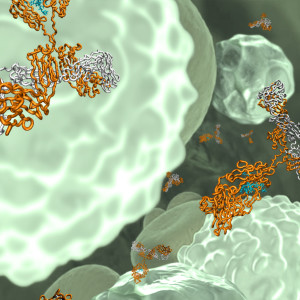 The possibility of using antibody therapeutics to modulate immune checkpoint pathways has captured the attention of many organizations involved in the research and development of cancer drugs. As of early May 2016, three antibody checkpoint inhibitors (ipilimumab / Yervoy®, pembrolizumab / Keytruda® and nivolumab / Opdivo®) have been approved for marketing, and one (atezolizumab) is undergoing regulatory review. In 2011, ipilimumab, which targets CTLA-4, became the first antibody of this class to be approved. Pembrolizumab and nivolumab, which target PD1, were subsequently granted first approvals in 2014. These drugs are currently marketed as treatments for melanoma and non-small cell lung cancer (NSCLC), but they have also undergone evaluation as treatments for other cancers, e.g., head and neck squamous cell carcinoma. A marketing application for the use of anti-PD-L1 atezolizumab as a treatment for urothelial carcinoma is undergoing a priority review by the Food and Drug Administration (FDA), and a regulatory action is expected in September 2016. An FDA action on a second application for use of atezolizumab as a treatment for NSCLC is expected in October 2016.
The possibility of using antibody therapeutics to modulate immune checkpoint pathways has captured the attention of many organizations involved in the research and development of cancer drugs. As of early May 2016, three antibody checkpoint inhibitors (ipilimumab / Yervoy®, pembrolizumab / Keytruda® and nivolumab / Opdivo®) have been approved for marketing, and one (atezolizumab) is undergoing regulatory review. In 2011, ipilimumab, which targets CTLA-4, became the first antibody of this class to be approved. Pembrolizumab and nivolumab, which target PD1, were subsequently granted first approvals in 2014. These drugs are currently marketed as treatments for melanoma and non-small cell lung cancer (NSCLC), but they have also undergone evaluation as treatments for other cancers, e.g., head and neck squamous cell carcinoma. A marketing application for the use of anti-PD-L1 atezolizumab as a treatment for urothelial carcinoma is undergoing a priority review by the Food and Drug Administration (FDA), and a regulatory action is expected in September 2016. An FDA action on a second application for use of atezolizumab as a treatment for NSCLC is expected in October 2016.
The biology of immune checkpoint pathways is complicated, and the use of antibodies to modulate numerous immune checkpoint targets is being explored. At least 45 antibody checkpoint modulators are currently undergoing evaluation in clinical studies of patients with a variety of cancers. In addition to CTLA-4, PD1 and PD-L1, other targets for antibodies in the clinic include B7-H3, CD70, CD40, CD137, GITR, OX40, KIR, LAG-3 and TIM3. Antibodies that modulate immune checkpoints are now ~16% of the entire clinical pipeline of antibodies for cancer, but most (~80%) are in early stage (i.e., Phase 1 or 1/2) clinical studies. First-in-human studies for over 20 antibody checkpoint modulators were initiated in 2015, and given the intense interest in the topic, many more are expected to enter clinical studies in the near future. Much work remains to be done, however, to demonstrate the relevance of some targets, and to determine suitable treatment regimens, especially when the antibody is administered as part of combination therapy. If the potential of this class of molecules is realized, unmet medical need could be reduced, and patients’ choice of antibody therapeutics could substantially increase, in the next 5-10 years.

